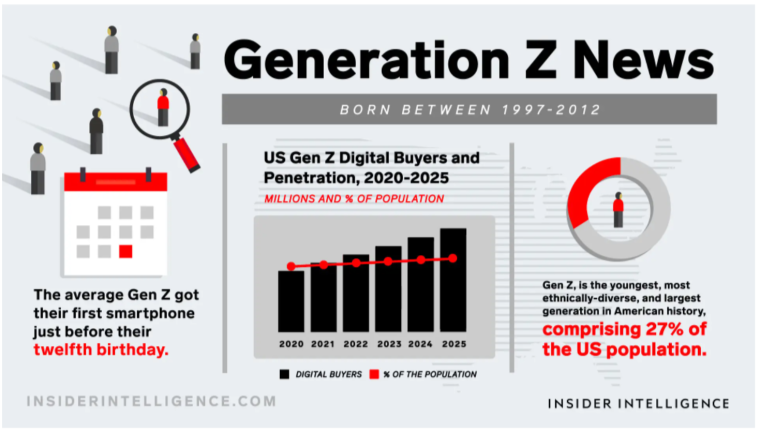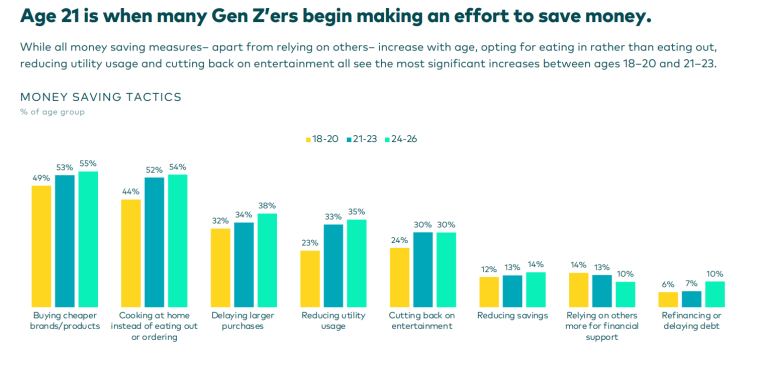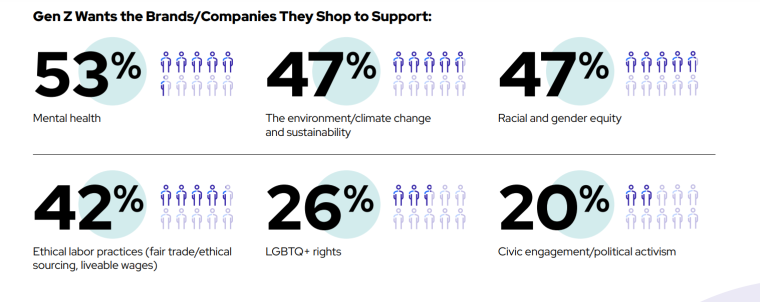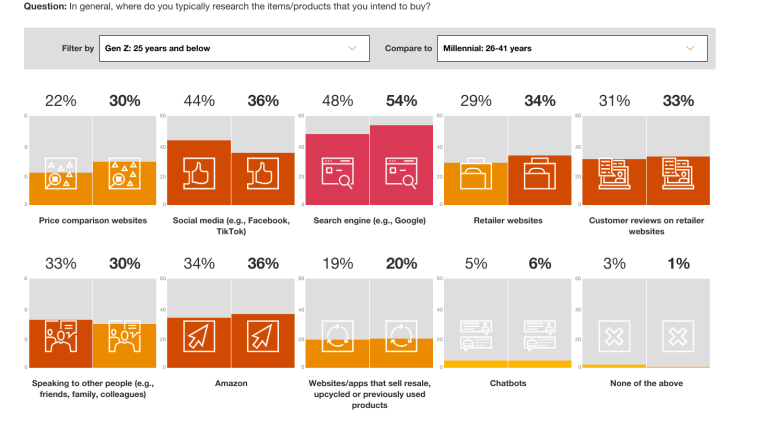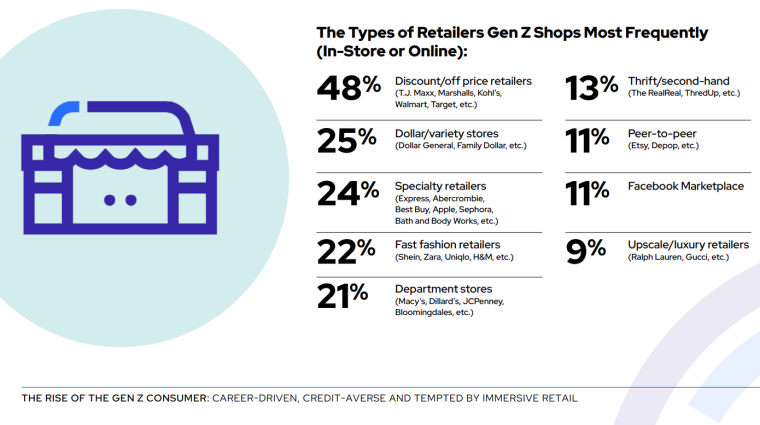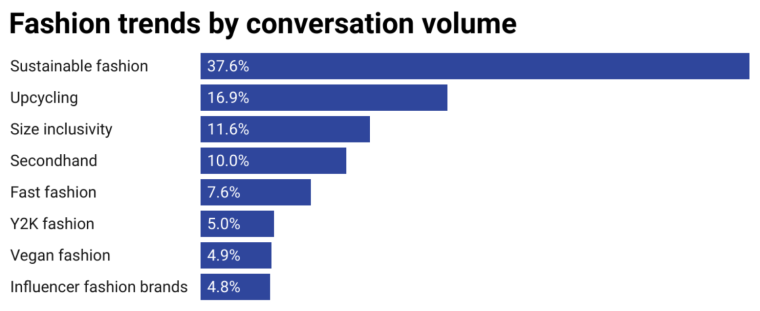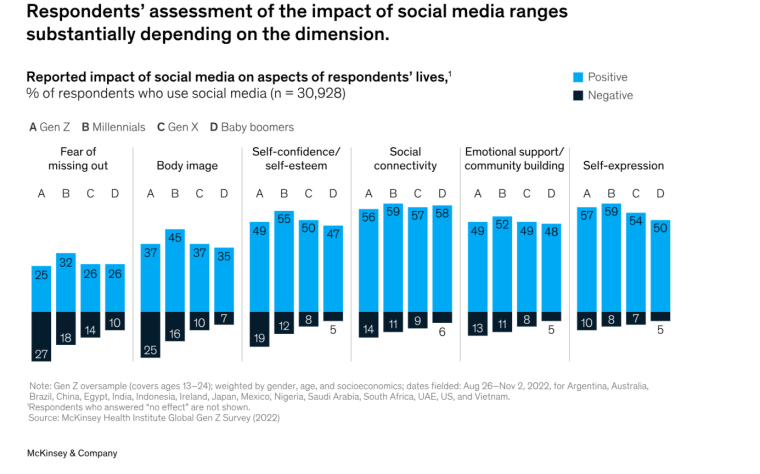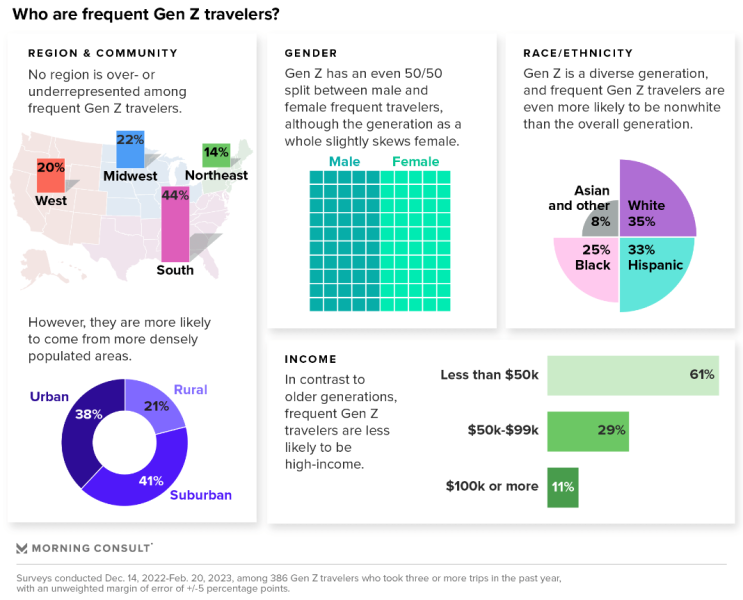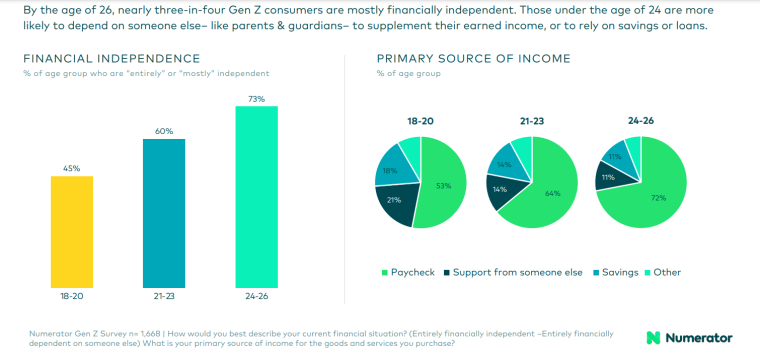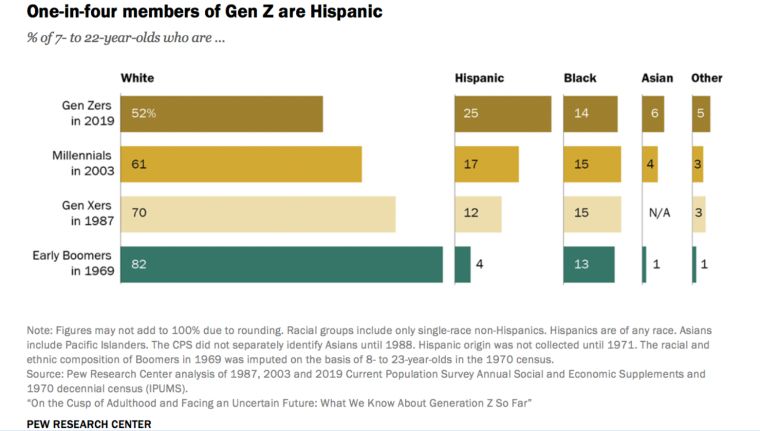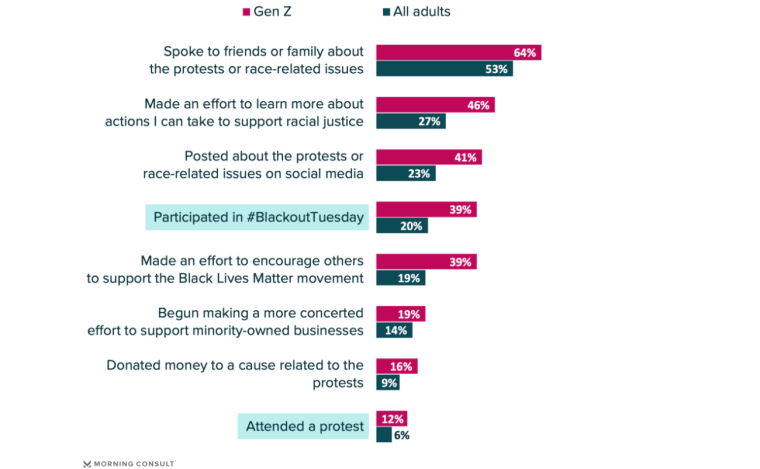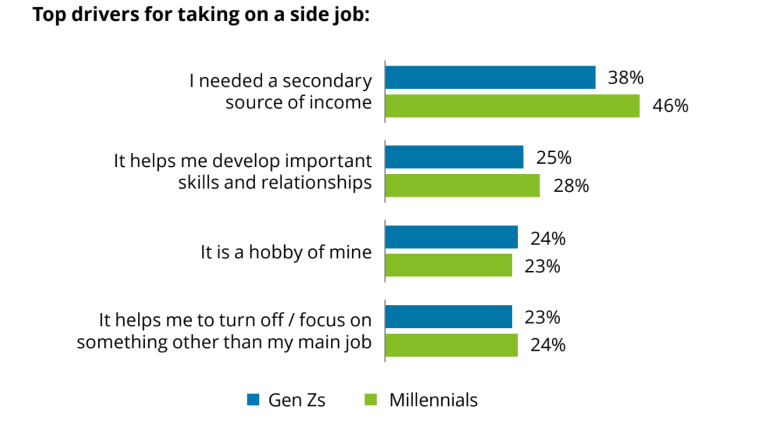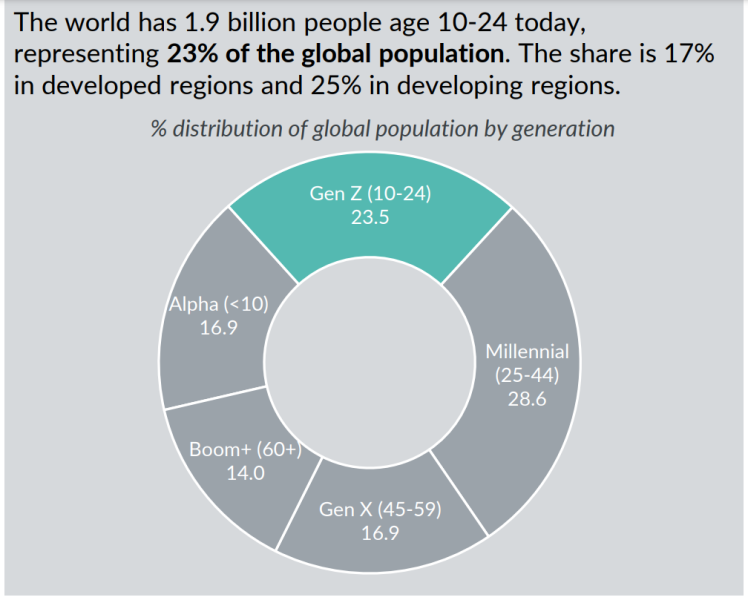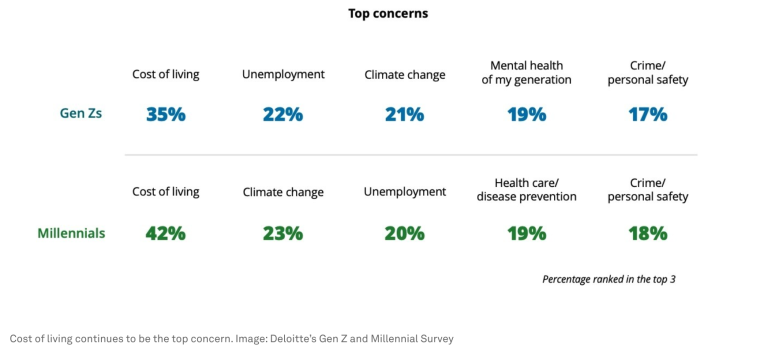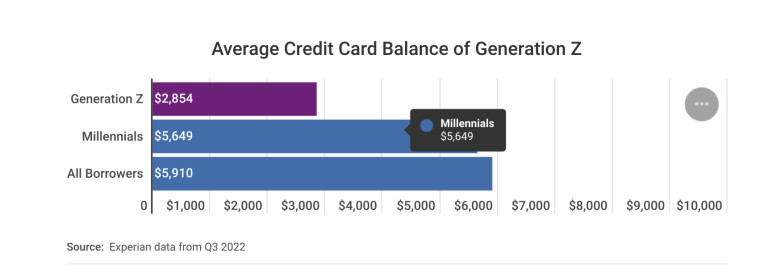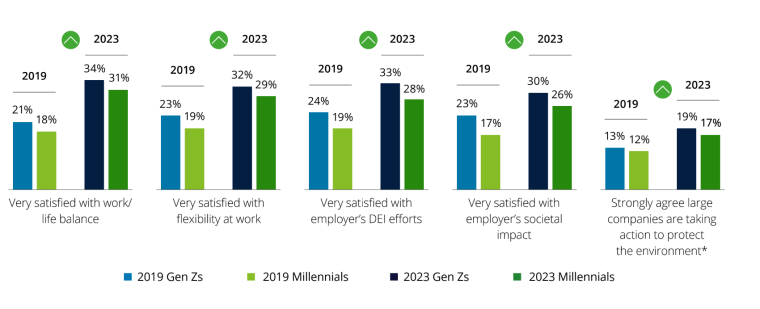Born between 1997 and 2012, Generation Z or Gen Z accounts for up to one-quarter of the global population and is on track to become the largest group of consumers within the decade.
To reach this dynamic generation, businesses and marketers will need to drill down into Gen Z trends and desires.
Deciphering all there is to know about Generation Z can be challenging, which is why we’ve pulled together all of the most impactful Gen Z trends for 2025.
Keep reading to discover all the latest data on Gen Zers including their values, buying power, spending habits, and more.
Generation Z Trends Data
- Gen Z accounts for 27% of the US population and 25% of the global population.
- Gen Z’s spending power is set to exceed $33 trillion over the next decade.
- Key Gen Z trends such as 00s nostalgia are set to continue throughout 2023.
- Core values such as sustainability and affordability shape Gen Z’s shopping habits.
- Remote work and diversity are top priorities for Gen Z employees.
Key Takeaways
- Expanding Influence: Generation Z is rapidly becoming a dominant force in the global market with their unique trends and substantial buying power.
- Digital Natives: This generation is deeply integrated with digital technology, heavily influencing their shopping habits, media consumption, and social interactions.
- Value-Driven Consumers: Gen Z prioritizes sustainability, ethical practices, and companies with strong missions, showing a preference for brands that align with their social and environmental values.
- Preference for Authenticity: They rely on social media and influencers for brand discovery and product recommendations, favoring user-generated content and real reviews over traditional advertising.
- Adapting Commerce: With their cost-conscious approach, Gen Z prefers online shopping, secondhand markets, and values convenience in their purchasing journey.
Gen Z Buying Trends
As per a 2023 GFK report, Generation Z has the fastest growing buying power of any generation globally. Their income is set to grow 400% over the next ten years to exceed $33 trillion. This age group will hold more than 25% of global income by 2030 and surpass millennials’ purchasing power in 2031.
| Generation | Year Range | Average Annual Expenditure |
| Silent Generation | 1928-1945 | $44,683 |
| Baby Boomers | 1946-1964 | $62,203 |
| Generation X | 1965-1980 | $83,357 |
| Millennials | 1981-1996 | $69,061 |
| Generation Z | 1997-2012 | $41,636 |
Research by Numerator revealed that between the ages of 18 and 26, Gen Z spending shifts from discretionary (dining out and apparel) to essentials-focused. Groceries become the top category purchased independently as Gen Z shoppers age, replacing dining out.
Spending in categories such as entertainment, housing, and apparel increase with age, however not all categories experience linear growth. Grocery spending dips at around age 21-23 when many Gen Zers become more budget-conscious.
According to 2023 research by Jungle Scout, Gen Z consumers are setting a new standard for e-commerce:
- 43% of Gen Zers start their online product searches on TikTok, a higher number than those who start on Google.
- Despite rising inflation, 32% of Gen Z adults shop online at least once a day compared to 25% of millennials, 15% of Gen X, and 7% of baby boomers.
- Compared to other generations, Gen Zers are most likely to buy secondhand items online to save money, with 42% purchasing a pre-owned item online in the past year.
Value-Driven Buying Decisions
According to McKinsey, Generation Z values sustainability, with many describing themselves as environmentally and socially conscious.
This generation chooses brands that have a strong mission or purpose, with 73% stating they buy from companies they consider ethical. Additionally, 90% believe that companies have a responsibility to address environmental and social issues.
This is consistent with findings from a 2023 ICSC report that show Gen Z is a socially and environmentally conscious generation that wants to support brands that align with their core values.
Mental health sits at the top of Gen Z’s values, with 53% of Gen Zers indicating that they want to support brands that prioritize this issue.
47% of Gen Zers express interest in supporting brands that address the following issues:
- The environment
- Climate change
- Sustainability
- Racial and gender equity
Social Media Driven Purchases
Gen Zers often turn to influencers, family, and friends to help shape their buying decisions. In the US alone, 40% of Gen Zers admit to having their buying decisions influenced by the brands featured in the videos they watch.
According to a Gen Z report by GWI, 30% of Gen Zers consider user-generated content on social media as a key source of buying inspiration. In fact, they’re 11% more likely to do this than any other generation.
Indeed, social platforms have become the main source of brand discovery and product research for Gen Zers, with the number of Gen Z turning to social for this reason increasing by 35% between 2023 and 2015. This is because they value recommendations and ideas from real people before making purchases.
According to the ICSC, social media is overtaking search such as Google when it comes to product research, discovering new brands, and shaping Gen Z’s shopping behavior. Instagram and TikTok are tied for first place, with 45% of Gen Z respondents citing them as influential in their buying decisions.
Other social media platforms that are influential in purchasing decisions include:
- YouTube (38%)
- Facebook (24%)
- Snapchat (17%)
- Twitter (14%)
- Reddit (7%)
Cost-Conscious Shopping
Although Gen Z shoppers are cost-conscious and prefer discount destinations, they are willing to pay more for experiences that meet their expectations. Close to half of the respondents in an ICSC survey said they were willing to pay a premium to have online orders delivered faster.
The same report found discount and off-price retailers like T.J. Maxx, Marshalls, Kohl’s, Walmart, and Target were the preferred shopping destinations of 48% of survey respondents. Other preferred shopping destinations include:
- Dollar and variety stores such as Dollar General and Family Dollar – 25%
- Specialty retailers, including Urban Outfitters, Abercrombie & Fitch, Best Buy, and Sephora – 24%
- Fast-fashion retailers such as Shein or Zara – 22%
- Department stores – 21%
- Thrift or second-hand stores – 13%
Accessibility and Convenience
The top shopping priorities for Gen Z include convenience, efficiency, and speed. Specifically, in the ICSC survey mentioned previously:
- 46% of Gen Z respondents rated quick and easy checkout as the most important factor in their shopping experience.
- Fast shipping (45%) and being able to get what they want in-store immediately (39%) were key factors.
- Free returns (31%) and quick/helpful customer service (27%) were also rated as important to Gen Z respondents.
- The ability to accurately check the availability of items ahead of time (23%) and the option to buy online and pick up items in-store (23%) were also top priorities.
Many Gen Zers also value access over ownership. Instead of buying movies or music, they subscribe to multiple streaming platforms. More than any other generation, they also prefer to make use of services such as car shares and luxury clothing rentals.
Gen Z Brands
Tech
According to Salesforce, 70% of Gen Zers report using generative artificial intelligence (AI), and 52% of them trust the technology to help them make informed decisions. Additionally, 52% say their use of generative AI is increasing.
More than any other generation, nearly 50% of Gen Zers say they’re interested in the metaverse. Among those interested, just over half intend to play games or watch TV/movies. Meanwhile, just under half say they’d like to meet up with friends/family or meet new people.
Due to nostalgia, privacy concerns, and the need to “digitally detox”, simple flip phones are making a major comeback with Gen Z. According to CNBC, flip phone sales are on the rise in the US. Samsung, Nokia, and Motorola are all releasing new versions of their classic flip phone models to cash in on the simplicity that the younger generation craves.

Gen Zers are opting to own both a smartphone and a flip phone, allowing them to reduce screen time and be more present in their daily lives without sacrificing the benefits of social media.
To avoid doom scrolling and being chronically online, they are also returning to single-use devices or retro tech, such as camcorders, disposable cameras, and Walkmans.
Fashion
Most Gen Zers value unique, expressive clothes. They also have fast-changing tastes inspired by the latest trends. That’s why brands like Shein, a fast-fashion giant that adds up to 6,000 new products to its website daily, have become a firm Gen Z favorite.
With 54% of Gen Z liking the style of vintage clothes, they’ve also brought back 90s and early 2000s fashion trends, with the nostalgia set to continue well into 2023.
In line with their calls for circular fashion, Gen Zers also enjoy thrifting. Fashion resale has experienced marked growth due to Gen Z resellers and influencers. It’s common for the typical Gen Z wardrobe to consist of fast fashion and treasured vintage pieces.
Entertainment
Brands like Netflix, Disney Plus, and Spotify continue to dominate Gen Z media consumption. When it comes to streaming services, content is king.
This generation expects:
- Content relevant to their interests.
- A large variety of original content.
- Regularly updated content.
In keeping with their cost consciousness, 55% of Gen Zers support the addition of an ad-supported tier on a streaming service to help drive down costs. In 2022, brands like Netflix and Disney Plus joined HBO Max and Hulu in offering cheaper ad-supported tiers.
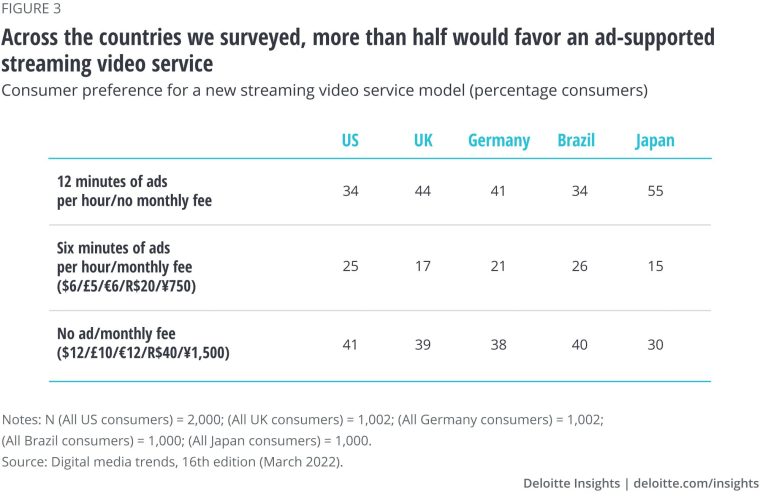
According to GWI, Gen Z mainly listens to music to escape reality (42%) and lift their mood (54%). As music genres become harder to define, brands like Spotify have had major success creating playlists to match different moods.
Social Media
As digital natives, Gen Z is the first generation to have unlimited access to the internet and mobile devices from a young age. It’s not surprising that Gen Zers spend six or more hours per day on their phones keeping up with:
- Consumer shopping trends
- Entertaining content
- New brands
- Gaming
- Pop culture
- Work or interests
- Friends and family
TikTok, Snapchat, Tumblr, and Reddit are 2-3x more popular with Gen Zers than other generations. In particular, video sharing app TikTok has skyrocketed in popularity as Gen Z comes of age. TikTok is the prime destination for Gen Zers, who make up over 60% of TikTok users.
Unlike previous generations, Gen Zers curate their mental health and online selves more carefully. Data from GWI shows a drop in overall Gen Z social media use caused by mental health concerns. Nevertheless, social media use for the generation and others is close to an all-time high.
Additionally:
- A third of Gen Z worry they’re spending too much time on social media.
- 20% say social media causes them anxiety; 25% more than other generations.
- More Gen Z women than men say social media has a negative impact on FOMO (32% vs. 22%), body image (32% vs. 16%), and self-confidence (24% vs. 13%).
Travel
Because of their ever-changing tastes, Gen Zers are more likely to spend money on experiences that enrich their day-to-day lives and mental health as opposed to luxury items.
Despite their youth and comparatively low income, Gen Zers travel just as frequently as Millennials. Just over half of Gen Z adults (52%) are frequent travelers, taking at least three leisure trips annually.
However, as Gen Zers age and their spending power increases, they’re likely to outpace travel-happy Millennials. For the 87% of Gen Z travelers getting their holiday inspiration from social media, YouTube, Instagram, and TikTok are their platforms of choice.
61% of Gen Zers who took three or more leisure trips in the past year come from households earning less than $50,000 annually. This suggests that the youngest generation isn’t waiting until they have a certain amount of income or savings to see the world; they’re prioritizing travel and finding ways to fit it into their budgets now.
Finance
When it comes to their finances, Gen Zers care about accessibility and convenience. Mobile pay and other app-based services that make for seamless online transactions are important, and services such as Apple Pay and Cash App have found major success by restructuring to suit Gen Z tastes.
2023 research by ICSC revealed that when Gen Z members express unease about the economy, their personal finance and consumption habits value planning for instability.
- 41% say they save more money than they spend.
- 36% of respondents say they spend more money than they save.
- 20% report equally dividing their money between spending and saving.
- 73% of 24-26 year old Gen Zers are financially independent
The report further reveals that older Gen Zers prefer to use debit cards over other payment methods. This suggests that Generation Z is more cautious about debt than Baby Boomers and Millennials.
- 45% of respondents used debit cards to keep track of expenses, compared to only 21% who prefered cash.
- Credit cards were the third most popular payment method among survey respondents, accounting for 17% of their payment methods.
- Digital payments were among the least popular transaction methods. Just 14% of respondents said they prefer options like Apple or Samsung Pay, Venmo, or PayPal.
- Only 3% opt for buy-now-pay-later services offered at points of sale and e-commerce sites.
Gen Z Trends in Work, Diversity, and Sustainability
According to a 2020 report from Pew Research Center, Gen Z is the most ethnically and racially diverse generation in the US. This new generation represents the country’s shifting racial and ethnic makeup. For example:
- 52% of Gen Zers were non-Hispanic white in 2019 versus 61% of millennials in 2003.
- In Gen X vs. Gen Z, 70% were non-Hispanic white in 1987 vs. 52% for Gen Z in 2019.
- Looking at Boomers vs. Gen Z, 82% were non-Hispanic white in 1969 vs. 52% for Gen Z in 2019.
Social Justice Gen Z Trends
Just as the Silent Generation was shaped by World War II and Millennials by the September 11 attacks, Gen Z’s worldview has been shaped by:
- The digital age
- Climate anxiety
- A shifting financial landscape
- The COVID-19 pandemic
They are also the most concerned about diversity, social justice, sustainability, and climate issues.
Often called the “social justice gen”, this generation has strong social awareness and places more importance on social activism than their older counterparts.
Research by Deloitte shows that Gen Zers want to solve problems. They also demand purpose and accountability from employers, brands, and society as a whole.
They’re a generation that values the creation of more opportunities for ethnic minorities and people from diverse or underrepresented backgrounds.
Climate Change Gen Z Trends
According to findings by McKinsey, Gen Zers report feelings of “climate anxiety”, with many citing they think about the fate of the planet on a daily basis.
Climate change is a major concern for Gen Zers. It has a significant impact on their decision-making, from family planning and home improvements, to what they eat and wear, to career and workplace choices.
However, finances are making it harder for them to prioritize sustainability.
- More than 50% of Gen Zers worry it will become harder or impossible to pay more for sustainable products and services if the economic situation stays the same or worsens.
- Research by GWI shows that due to a tough economic climate, Gen Z appears to be feeling jaded in their efforts to battle climate change, with their interest in environmental issues having fallen by 3% since Q1 2021.
Gen Z Employment Trends
According to CNBC, Gen Z will account for one-third of the workforce by 2025. Pew Research Center data shows that as well as being more racially and ethnically diverse than any previous generation, they are also on track to be the most well-educated generation yet.
As per research by Deloitte, this generation of digital natives is drawn to working in the tech industry. 51% of those surveyed rate technology as the top industry to work in. However, Gen Z women seek roles in technology at a much lower rate (34%) than their male counterparts (73%).
In addition:
- Meaningful work is important to over 80% of Gen Z.
- 77% of Gen Zers want to work at companies whose values align with their own.
- 41% are drawn to work that supports the greater good, such as education (41%) and healthcare (37%).
Gen Zers are more likely to have independent jobs or multiple jobs than older workers. They have started to normalize making money outside of the traditional 9-to-5. Because of technology and the gig economy, they’ve been exposed to new career paths in social media and content creation.
An ICSC report found that:
- 56% of Gen Z respondents rely on a job, freelance work, a “side hustle”, or their own business as a primary source of income.
- 25% reported receiving financial support from their parents or guardians.
- 10% received income from a spouse or partner.
Gen Z vs. Millennials
The Millennial generation, also known as Generation Y, includes anyone born between 1981 and 1996 (ages 26 to 41 in 2023) and represents about 25% of the US population. However, Gen Z will overtake Millennials or Generation Y by 2034.
Outlook
Generation Z is less optimistic about the future. According to Insider Intelligence, Gen Z mirrors Millennials on social and political issues, but without the optimism. 68% of Gen Zers in the US feel the US is headed in the wrong direction, and fewer Gen Zers than any other generation (32%) feel the country is headed in the right direction.
Gen Zers are coming into their own under decreased economic opportunity. In a McKinsey survey, 58% of Gen Zers (the largest percentage by far of any generation) reported not having a basic social need met. Unlike other generations, they don’t expect this period of financial insecurity to end and have major doubts about their eventual ability to either buy homes or retire.
Finances
In 2023, Deloitte surveyed 14,483 Gen Zs and 8,373 Millennials and found that while financial issues remain top-of-mind for both age groups, Gen Z isn’t as optimistic about their financial prospects. 35% of Gen Zers expect their personal financial situation to improve in the next year compared to 44% of Millennials.
Gen Zers and Millennials are responding to the financial crisis by:
- Taking on more side jobs in 2023 compared to 2022.
- Postponing major life decisions such as buying property or starting a family.
- Adopting behaviors that save money such as buying second-hand clothes or not driving a car.
Gen Z is more credit-averse than Millennials and other older generations. Research by Experian revealed that:
- Gen Z has a credit card balance of $2,854 while Millennials have a balance of $5,649.
- Gen Z has an average auto loan balance of $19,223 compared to $23,045 for Millennials.
- Gen Z has an average student loan balance of $20,468 while Millennials stand at $40,614.
Social Media Use
Almost half of both younger Millennials and Gen Z check social media multiple times a day. Over one-third of Gen Zers spend more than two hours each day on social media sites. However, Millennials are the most active social media users, with 32% stating they post either daily or multiple times a day.
According to S&P Global, more Gen Z adults (84%) than Millennials (73%) rely on social media for TV/video entertainment discovery.
Additionally:
- 77% of Gen Z adults compared to 67% of Millennials rely on social media for news of current events.
- 47% of Gen Zers and 46% of Millennials use social media for customer service issues, compared to only 29% of Gen Xers and 21% of Baby Boomers.
- 49% of Gen Z adults and 48% of millennials say ads and posts on social media influence their product purchases compared to 26% of Gen Xers and 20% of baby boomers and seniors.
Work Factors
49% of Gen Zs vs. 62% of Millennials say work is central to their identity and work/life balance is something they strive for and look for in a new employer.
Both Gen Zers and Millennials value remote and hybrid work and see its benefits. 75% of those working in remote or hybrid roles would consider looking for a new job if their employer asked them to return to the office full-time.
According to 2022 research by Upwork, 43% of all Gen Zers compared to 46% of Millennial professionals freelanced. For both age groups, the top reason for freelancing was being able to pursue meaningful work.
46% of Gen Z workers vs. 39% of Millennials say they feel stressed or anxious at work all or most of the time. Additionally, 61% of Gen Zs compared to 49% of Millennials have experienced harassment or microaggressions at work in the past 12 months.
Wrapping Up: Gen Z Statistics
As Generation Z continues to mature into their economic and social influence, businesses and marketers need to adapt by prioritizing authenticity, technology, and values that resonate with this dynamic demographic.
Understanding and engaging with Gen Z’s unique characteristics and preferences will be crucial for brands looking to thrive in a rapidly evolving consumer landscape.

